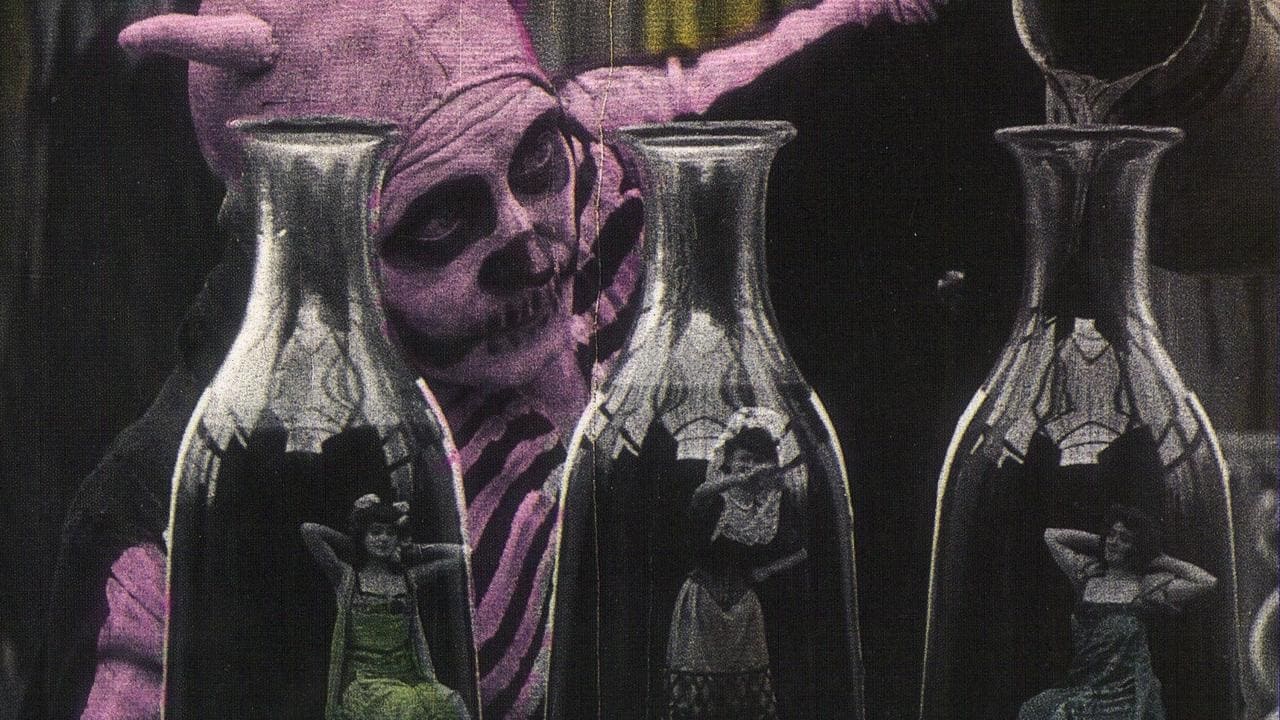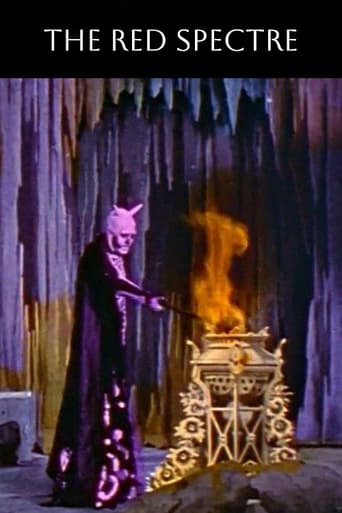

Also, the story for this is somewhat confusing; if I hadn't seen the brief plot summary on Letterboxd, I wouldn't know (until near the end anyway) that this was about a Good Woman fighting the devil or a demon of hell or whoever this guy in a robe and skull-face is. It seemed if it was about a woman who might have even been this demon's boss, or maybe even some annoying underling, screwing with this Demon-Man has a penchant for bottling up women (literally, you can see this in full close-up, and that's how it seems - a full 8 years before Griffith did it in in Birth of a Nation you get a close-up, albeit in camera and with separate shots without a cut).But at any rate, this is a fun short because the filmmaking is clever and inventive: we're seeing the process this devil takes with his female wares/prisoners, and it's through blazing red and orange colors (thanks silent film technology!) and with a magician's eye for trickery. By the end 'good' does prevail, but the joy is in the evil, if that makes sense; it's filmmakers reveling in the villainy of this Demon, or at least playing with the line between showing something as being *bad* as in a devil, or something that is... enjoyable to do, like, uh, bottling up women and making them prisoners. Or slaves. Or, I don't know what. This is simply cool, and it also empowers women to fight Satan's ways at the end of it all! How to do that, well, don't look at this for answers to that question, just watch magic tricks!
... View MoreI must say I had expected more of this, though I did quite enjoy myself. I came across a version without music, but I'm sure it's not intended that way, so I chose some Spanish guitar songs from Pepe Romero to play as soundtrack, and it sufficed for the greater part.The 'story' was pretty hard to follow, although all there seems to be going on is a horned reaper / magician performing his black arts on some harmless, innocent women (but are they ever...?), but in the end he meets his demise through one of them.It's full of visual playfulness and ingenuity that makes it quite pleasing to the eye, though I had expected a little more in terms of different settings and such.Still, this is very much up my alley. 8 out of 10.
... View MoreThe Red Spectre is a trick film from France in the style of Georges Méliès; although this one was directed by Ferdinand Zecca. It has all of the visual invention you would expect and it also has a nice red coloured tint which is perfect for its atmosphere.It's set in an underground cavern and features a demon warlock. This evil character possesses souls of several women. He manipulates them in several ways and generates television-like screens. All the while he is counterbalanced by a female nemesis that thwarts his evil actions and ultimately destroys him.It may be a short film but it's full to the brim with visual ideas. Characters appear and disappear, are shrunken and burst into flames. Walls are constructed and turn into giant monitors and rock faces move aside to show a cavern full of hell-like fires. It's relentlessly inventive basically. Worth seeing if you like the visual innovation of the earliest days of cinema.
... View MoreThe first decade of the twentieth century saw the production of dozens of brief "trick films" which pushed the boundaries of the new medium, and France was the capital of this activity. Georges Méliès is the best known creator of these films, but The Red Spectre, which was produced at the Pathé Studio as a collaboration between Méliès' fellow pioneers Ferdinand Zecca and Segundo De Chomon, is perhaps the most bizarre and fascinating of them all. Or at least, allowing for the fact that so many of these films are lost, it certainly ranks with the best of the survivors. It is better seen than described, genuinely dreamlike in its images and transitions, and quite strange, but quite satisfying as well. The action lasts only about 8 or 9 minutes, but when it's over you feel as if you've been permitted to visit another world. When The Red Spectre was first exhibited the black & white footage was hand-colored to produce a dazzling effect, and happily, this material survives: a color print was discovered in a junk-yard in Mexico, and purchased for $25.00!Our setting is a mysterious underground grotto, and our "host" is a demonic magician who seems to be toying with the souls or spirits of several captive women. He causes them to levitate, then burst into flames; he captures their ashes in bottles, brings them back to life in miniaturized form, etc. The magician is opposed throughout by a Good Fairy who resembles Peter Pan (portrayed by a woman, as Peter traditionally is on stage). The precise meaning of the action is difficult to determine at times, but the central conflict amounts to a struggle between the forces of Good and Evil.One effect is especially notable: when the wicked magician produces three glass bottles, each holding a tiny woman prisoner, and brings them downstage to allow for a close-up, the scene instantly reminds latter day viewers of a similar sequence in The Bride of Frankenstein (1935). Did James Whale see this film, or is the similarity a coincidence? Notable, too, is the depiction of a device very much like television-- strongly suggested by the evil conjurer's magic screens, each of which depicts a series of moving images. Here's a real cinematic milestone: a film that predicts the coming of T.V., and, on top of that, attributes its invention to a demon!
... View More